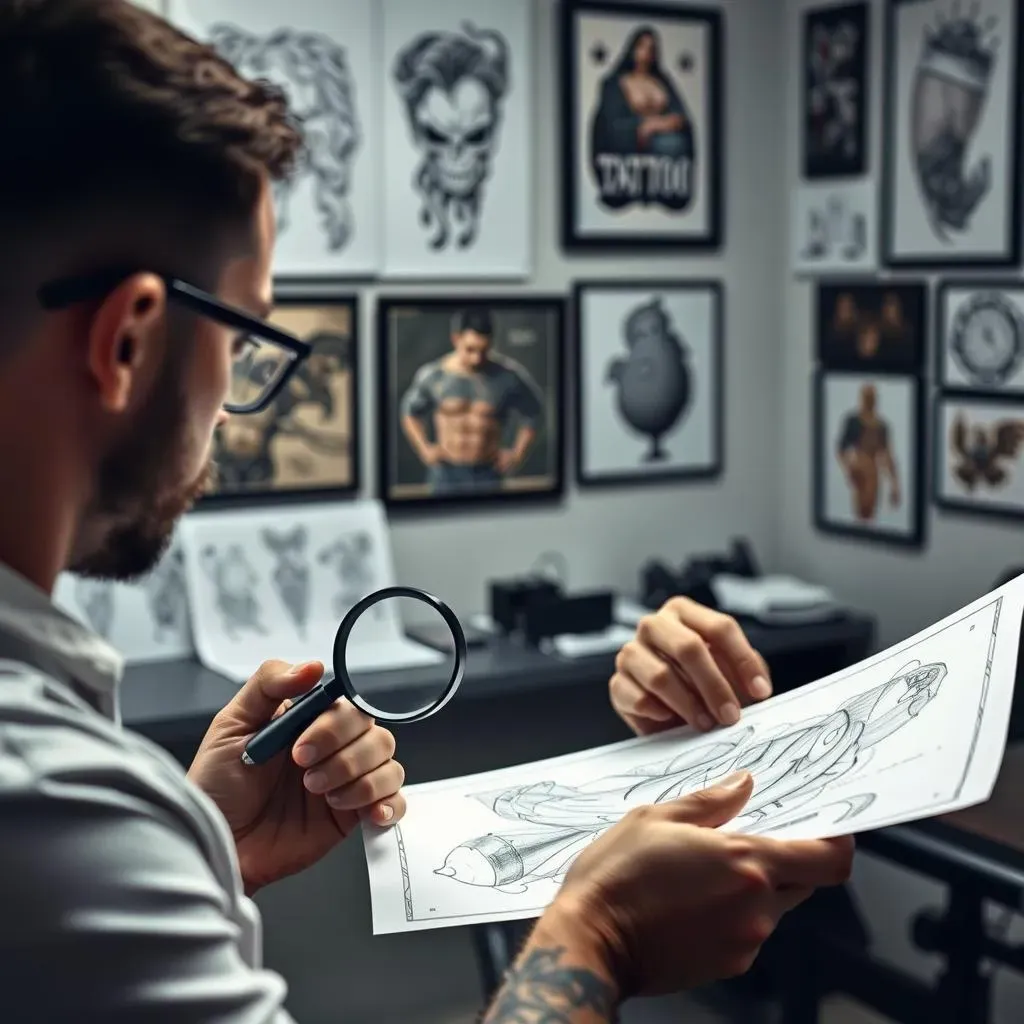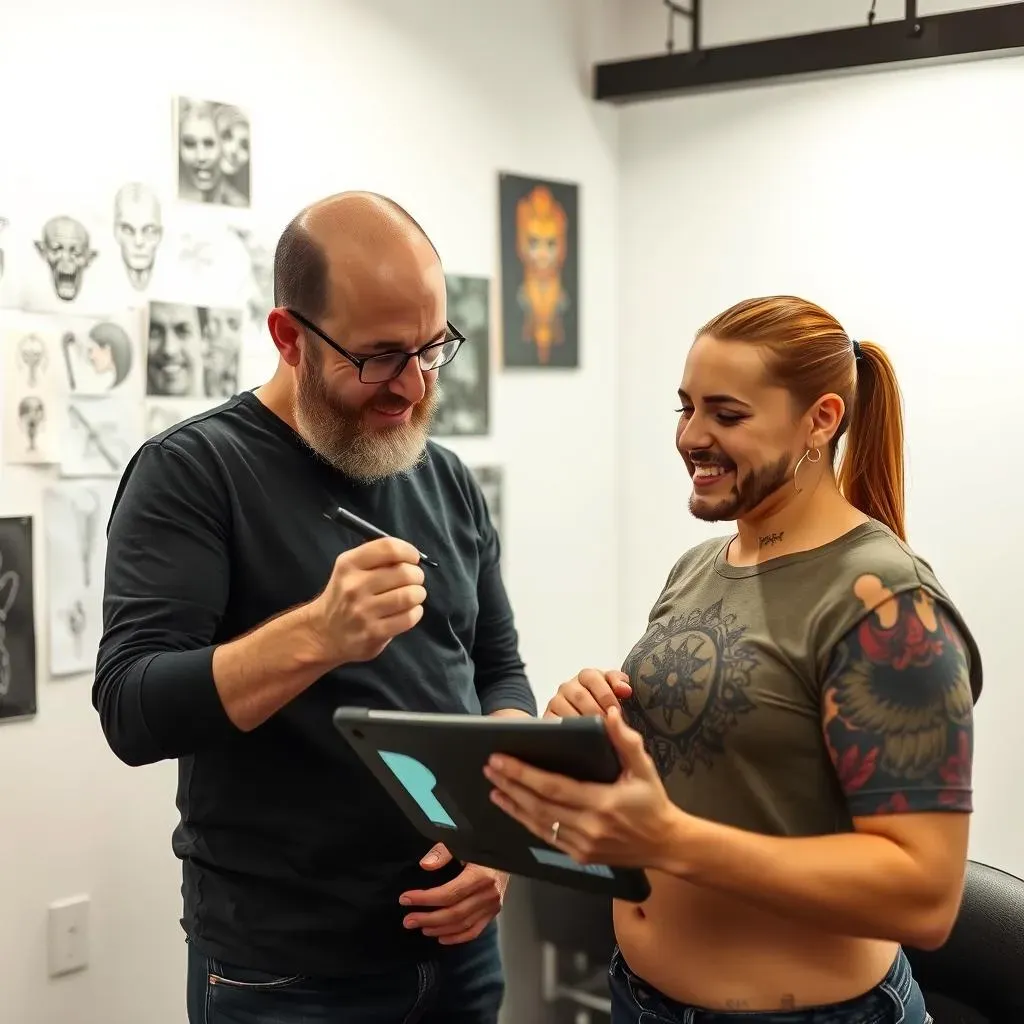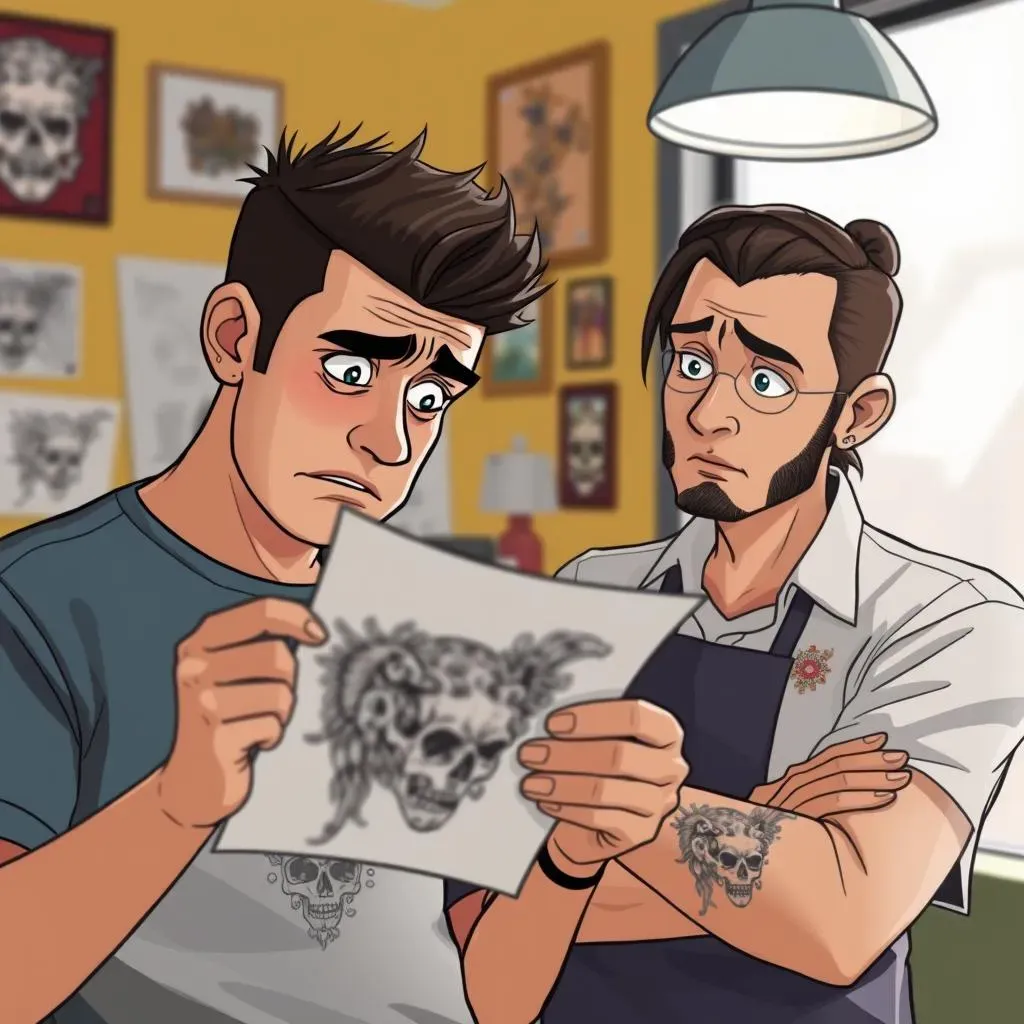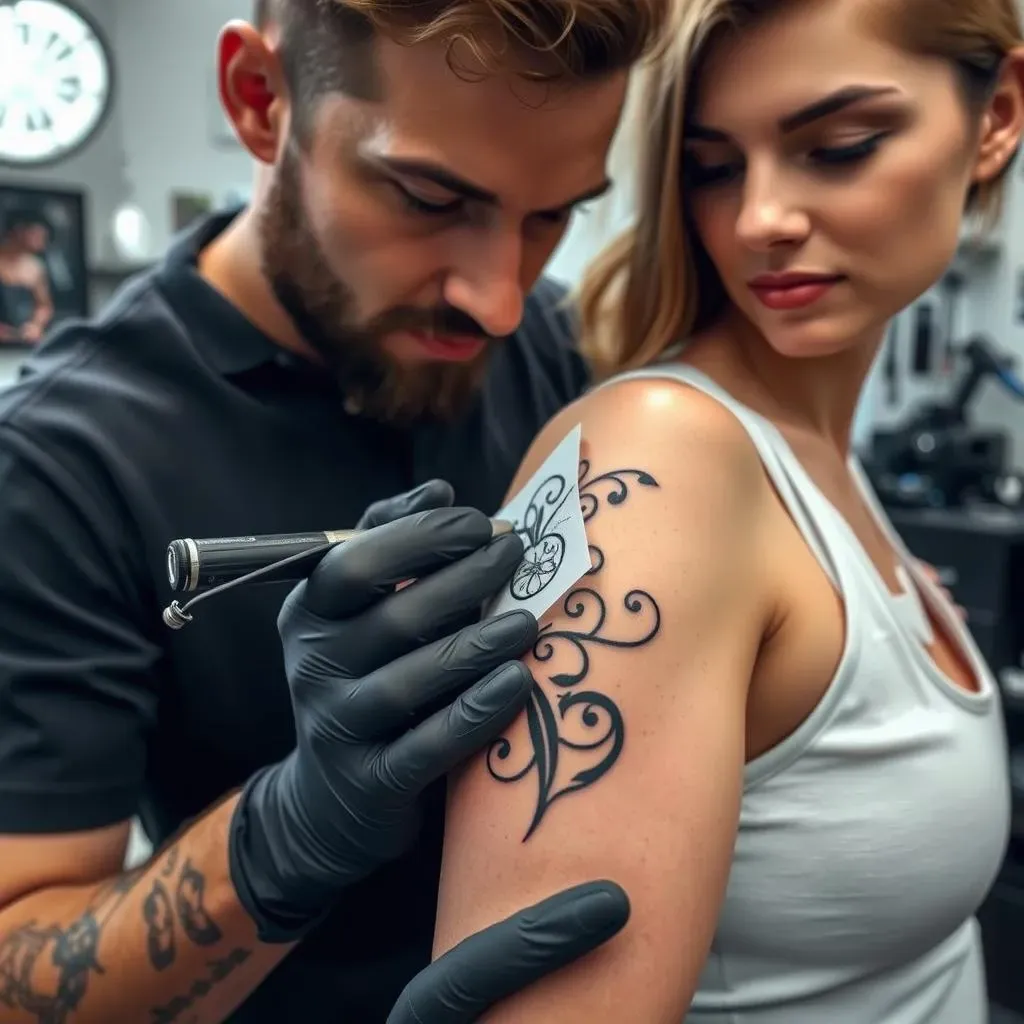Table of Contents
So, you've got a tattoo design swirling around in your head, or maybe you've even sketched it out already. The big question is: will a tattoo artist do my design? It's a common concern for anyone looking to get inked with something truly personal. The good news is, most tattoo artists are open to working with your ideas, but there are a few things you should keep in mind to ensure the process goes smoothly. We'll dive into how to approach an artist with your design, what to expect in terms of collaboration and revisions, and address any copyright concerns that might pop up. Plus, we'll tackle the tricky situation of what happens if an artist isn't vibing with your concept. By the end of this, you'll be armed with the knowledge to confidently walk into a tattoo shop and get the custom ink you've been dreaming of. Let's get started!
Submitting Your Own Design: Will a Tattoo Artist Do It?
Submitting Your Own Design: Will a Tattoo Artist Do It?
Your Design, Their Canvas: The Reality
So, you've meticulously crafted a design, every line and shade exactly as you envisioned. You're probably wondering, "Will a tattoo artist do my design exactly as I've presented it?" The short answer is: it depends. Most artists are happy to work with pre-made designs, especially if they're well-executed and fit their style. After all, it saves them the time of creating something from scratch. However, be prepared for the possibility that they might suggest tweaks or adjustments. This isn't necessarily a criticism of your artistic abilities; it's often about ensuring the design translates well onto skin and holds up over time.
Think of it like bringing a blueprint to a builder. They'll appreciate the detailed plans, but they might need to make structural adjustments to ensure the house stands strong. A good tattoo artist will explain their reasoning behind any suggested changes, whether it's about line weight, shading, or color choices. Be open to these suggestions; they're coming from a place of experience and a desire to give you the best possible tattoo.
What Makes a Design "Tattoo-Ready"?
Not all designs are created equal when it comes to tattooing. A beautifully rendered drawing on paper might not translate well to skin. There are a few key factors that artists consider when assessing a pre-made design. Line weight is crucial; lines that are too thin can fade or blur over time, while lines that are too thick can look heavy and unflattering. Shading is another important element. Gradual shading can be difficult to achieve and maintain, so artists may suggest simplifying the shading or using bolder contrasts. Color choices also matter. Some colors fade faster than others, and certain colors can react differently depending on the individual's skin tone.
Consider the size and placement of your design. A tiny, intricate design might look amazing on paper, but it could become a blurry mess when shrunk down and applied to skin. Similarly, a design with a lot of fine details might not be suitable for areas of the body that are prone to stretching or movement. Before approaching an artist, take a step back and critically assess your design. Is it bold enough? Is it simple enough? Is it appropriate for the chosen location? If you're unsure, don't hesitate to ask for feedback from friends, family, or even online tattoo communities. Getting a second opinion can help you identify potential issues and make necessary adjustments before consulting with an artist.
Factor | Consideration |
|---|---|
Line Weight | Thick enough to last, not too thick to look heavy. |
Shading | Simplified for longevity, bold contrasts. |
Colors | Durable pigments, skin tone compatibility. |
Size & Placement | Appropriate for detail level, body movement. |
Collaborating with a Tattoo Artist on Your Custom Design
Collaborating with a Tattoo Artist on Your Custom Design
Finding the Right Artist: Style and Specialization
so you're ready to take the plunge and get that custom design inked. The first step? Finding the right artist. Not all tattoo artists are created equal; they each have their own unique style and specialization. Some excel at traditional tattoos with bold lines and classic imagery, while others are masters of realism, creating stunning portraits and landscapes. Some artists are amazing with fine-line work, others love doing large-scale pieces. Before you even think about discussing your design, do your research. Scour Instagram, check out local tattoo shop websites, and ask for recommendations from friends. Look for an artist whose style resonates with you and who has experience tattooing similar designs.
Don't just walk into the nearest tattoo shop and assume they can perfectly execute your vision. Imagine wanting a watercolor painting and hiring an oil painter – the results might not be what you hoped for. When you find an artist whose style you admire, take a closer look at their portfolio. Do they consistently produce high-quality work? Are their lines clean and crisp? Is their shading smooth and well-blended? Pay attention to the details and make sure their skills align with your expectations. Once you've identified a few potential artists, reach out and schedule a consultation. This is your chance to discuss your design in detail, ask questions, and get a feel for their personality and approach.
The Consultation: Communicating Your Vision
The consultation is a crucial step in the collaborative process. This is where you'll sit down with the artist, discuss your design ideas, and work together to create a tattoo that you'll both be proud of. Come prepared with reference images, sketches, and any other materials that will help the artist understand your vision. Be as clear and specific as possible when describing what you want. Don't just say "I want a flower tattoo"; instead, say "I want a realistic depiction of a peony in full bloom, with soft pink petals and delicate green leaves." The more information you provide, the better equipped the artist will be to bring your idea to life.
Be open to the artist's suggestions and feedback. Remember, they're the expert when it comes to tattooing, and they may have valuable insights on how to improve your design. They might suggest changes to the line weight, shading, or color palette to ensure the tattoo looks its best and holds up well over time. Don't be afraid to ask questions and express your concerns. This is a collaborative process, and you should feel comfortable voicing your opinions and working together to find solutions. If you're not happy with something, speak up! It's better to address any issues during the consultation than to end up with a tattoo that you regret.
From Concept to Skin: The Design Process
After the consultation, the artist will typically create a preliminary sketch or digital mock-up of your design. This is your opportunity to review the design and provide feedback. Be honest and specific with your comments. If you don't like something, explain why and suggest alternative solutions. The artist may need to make several revisions before you're both completely satisfied with the design. Don't rush the process; take your time to carefully review each iteration and make sure it aligns with your vision.
Once you've approved the final design, the artist will create a stencil, which is a temporary transfer of the design onto your skin. This allows you to see exactly how the tattoo will look on your body before the actual tattooing begins. Take a good look at the stencil in the mirror and make sure you're happy with the placement, size, and overall appearance. If you need to make any adjustments, now is the time to do so. Once the tattooing begins, it's much more difficult to make changes. Trust your gut and don't be afraid to speak up if something doesn't feel right. Remember, this is your body, and you deserve to have a tattoo that you absolutely love.
Step | Description | Your Role |
|---|---|---|
Initial Consultation | Discuss your ideas and vision with the artist. | Bring references, be clear and specific. |
Preliminary Sketch | The artist creates a first draft of the design. | Review carefully, provide honest feedback. |
Revisions | The artist makes changes based on your feedback. | Collaborate, ask questions, express concerns. |
Stencil Application | The design is temporarily transferred to your skin. | Confirm placement, size, and overall appearance. |
Copyright Concerns When a Tattoo Artist Uses Your Design
Copyright Concerns When a Tattoo Artist Uses Your Design
Who Owns the Ink? Understanding Copyright Law
let's talk about something that might not be the first thing on your mind when you're thinking about getting a tattoo, but it's super important: copyright. When you bring your own design to a tattoo artist, or even collaborate on a design, the question of who owns the rights to that design can get a little murky. Generally, the person who creates the original artwork holds the copyright. So, if you designed the whole thing yourself, you own the copyright. However, if the tattoo artist significantly contributes to the design, they might have a claim to partial copyright, especially for the elements they added. The key phrase here is "significantly contributes." Minor tweaks or adjustments usually aren't enough to transfer copyright ownership.
Now, here's where it gets interesting. Even if you own the copyright to your tattoo design, that doesn't necessarily mean you can prevent the tattoo artist from using it in their portfolio or displaying it as an example of their work. Tattoo artists have a legitimate interest in showcasing their skills and attracting new clients. However, they shouldn't reproduce your design for commercial purposes without your permission. For example, they can't sell prints of your tattoo design or use it to create merchandise without your consent. It's all about finding a balance between protecting your creative rights and allowing artists to promote their work.
Protecting Your Creation: Agreements and Permissions
So, how can you protect your copyright and avoid potential conflicts down the road? The best approach is to have a frank and open conversation with your tattoo artist about copyright ownership and usage before you even start the design process. You can even create a simple written agreement that outlines who owns the copyright to the design and how it can be used. This agreement should address issues like: Who owns the design? Can the artist use the design in their portfolio? Can the artist sell prints or merchandise featuring the design? What happens if someone else wants to use the design?
If you're particularly concerned about protecting your copyright, you can also consider registering your design with the U.S. Copyright Office. This provides you with additional legal protections and makes it easier to enforce your rights if someone infringes on your copyright. However, keep in mind that copyright registration can be a time-consuming and expensive process, so it's not always necessary. Ultimately, the best way to protect your creation is to be proactive and communicate clearly with your tattoo artist. By addressing copyright concerns upfront, you can avoid misunderstandings and ensure that everyone is on the same page.
Concern | Solution |
|---|---|
Copyright Ownership | Discuss and agree on ownership with the artist. |
Artist's Portfolio Use | Define acceptable usage in a written agreement. |
Commercial Reproduction | Prohibit or allow with specific permission. |
Copyright Registration | Consider registering for stronger legal protection. |
What If a Tattoo Artist Doesn't Like My Design? Finding the Right Fit
What If a Tattoo Artist Doesn't Like My Design? Finding the Right Fit
It's Not You, It's the Tattoo (Maybe)
so you've poured your heart and soul into this design, and you're buzzing with excitement to get it inked. But what happens if you present it to a tattoo artist, and they're just... not feeling it? It can be a real bummer, but don't take it personally! There are several reasons why an artist might decline to work with your design, and it's not always a reflection of its artistic merit. Maybe it doesn't align with their style, perhaps they're not comfortable tattooing a particular subject matter, or it could be that they simply don't think it will translate well onto skin. Whatever the reason, it's important to respect their decision and not try to pressure them into doing something they're not comfortable with. Remember, a good tattoo artist will always prioritize the quality of their work and the satisfaction of their clients.
Think of it like this: you wouldn't ask a sushi chef to bake you a cake, right? Every artist has their strengths and weaknesses, and it's better to find someone who's passionate about your design than to force someone to do something they're not enthusiastic about. A tattoo is a permanent piece of art, and you want it to be created by someone who's genuinely excited about the project. So, if an artist turns down your design, don't despair! It just means you need to keep searching until you find the right fit. There are plenty of talented tattoo artists out there, and one of them will be thrilled to bring your vision to life.
Finding Your Tattoo Soulmate: The Search Continues
So, one artist passed on your design – big deal! The tattoo world is vast and varied, filled with artists who specialize in every style imaginable. This is your chance to explore different options and find someone who's not just willing to do your design, but genuinely excited about it. Don't be afraid to branch out and consider artists you might not have initially thought of. You might be surprised at what you discover! Use social media, online forums, and tattoo shop websites to research different artists and their work. Pay attention to their portfolios and look for artists who have experience tattooing similar designs. Read reviews and testimonials to get a sense of their personality and approach. The more research you do, the better equipped you'll be to find an artist who's the perfect fit for you.
When you find a potential artist, reach out and schedule a consultation. Bring your design, explain your vision, and ask questions about their process. Pay attention to their reactions and see if they seem genuinely interested and engaged. Do they offer helpful suggestions and feedback? Do they seem passionate about the project? Trust your gut and choose an artist who makes you feel comfortable and confident. Remember, this is a collaboration, and you want to work with someone who's on the same wavelength as you. With a little patience and persistence, you'll find the right artist to bring your tattoo dreams to life.
Scenario | Action |
|---|---|
Artist declines your design | Don't take it personally, respect their decision. |
Feeling discouraged | Remember there are many artists, keep searching. |
Finding a new artist | Research portfolios, read reviews, schedule consultations. |
Consultation | Bring your design, ask questions, trust your gut. |
Ensuring Your Tattoo Design is Perfect: Finalizing Details with Your Artist
Ensuring Your Tattoo Design is Perfect: Finalizing Details with Your Artist
The Devil's in the Details: Size, Placement, and Spacing
Alright, you've found an artist who vibes with your design, and you're both stoked to move forward. Now comes the crucial step of ensuring your tattoo design is perfect before the needle even touches your skin. This is where you really fine-tune the details and make sure everything is exactly how you want it. We're talking size, placement, spacing – the whole shebang. Size is a big one. A design that looks amazing on paper might not translate well to skin if it's too small or too large. Consider the level of detail in your design and how it will look when scaled up or down. A tiny, intricate design might become a blurry mess, while a large, simple design might look underwhelming. Work with your artist to find the sweet spot that showcases your design in the best possible light.
Placement is equally important. Where you put your tattoo can drastically affect its appearance and longevity. Areas that are prone to stretching or movement, like your wrists or ankles, might not be ideal for designs with a lot of fine details. Similarly, areas that are constantly exposed to the sun, like your shoulders or back, might cause colors to fade more quickly. Talk to your artist about the best placement options for your design and lifestyle. They can advise you on areas that will minimize distortion and maximize the lifespan of your tattoo. Finally, pay attention to spacing. Make sure there's enough negative space around your design to allow it to breathe. A tattoo that's too crowded or cluttered can look messy and difficult to read. Work with your artist to create a balanced and visually appealing composition.
The Stencil Test: Your Last Chance to Tweak
the design is finalized, the size and placement are locked in, and the artist has created a stencil. This is your last chance to make any tweaks or adjustments before the tattooing begins, so pay close attention! The stencil is a temporary transfer of the design onto your skin, and it allows you to see exactly how the tattoo will look on your body. Take a good look at it in the mirror, from different angles, and in different lighting conditions. Does it look exactly how you envisioned it? Are you happy with the size, placement, and overall appearance? If anything feels off, speak up! It's much easier to make changes to the stencil than it is to correct a mistake after the tattoo is already on your skin.
Don't be afraid to ask your artist to make adjustments to the stencil. They can move it slightly, adjust the size, or even make minor modifications to the design. Remember, this is your body, and you deserve to have a tattoo that you absolutely love. If you're not 100% happy with the stencil, don't proceed with the tattooing. Take the time to make the necessary changes until you're completely satisfied. It's better to be patient and get it right than to rush the process and end up with a tattoo that you regret.
Detail | Consideration | Action |
|---|---|---|
Size | Too small/large can distort the design. | Adjust to showcase detail and clarity. |
Placement | Affects appearance and longevity. | Choose areas with minimal stretching and sun exposure. |
Spacing | Too crowded can look messy. | Ensure enough negative space for visual balance. |
Stencil | Last chance to review and tweak. | Inspect carefully, request adjustments if needed. |
Wrapping Up: Your Design, Your Ink, Your Way
Ultimately, getting a tattoo that perfectly reflects your vision is totally achievable. While most tattoo artists are happy to work with your designs, clear communication, flexibility, and understanding the creative process are key. Don't be afraid to collaborate, ask questions, and find an artist whose style aligns with your own. By taking these steps, you'll not only end up with a killer tattoo but also a positive and memorable experience. So go forth, share your ideas, and get ready to wear your personalized art with pride!